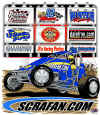


|
Traditional Sprint Car FanSite |
See You At The Races!!! |
| VRA Sprint Cars - Format |
|
|
|
An evening of sprint car racing at Ventura Raceway consists of four heat races, one (or more) B-mains, and the A-main (or “Feature” race). Heat Races: Ventura Raceway does not run qualifying (or “time trials”) for its sprint car division. Heat races are lined up by drawing numbered pills. The lowest pill drawn starts on the pole (first row inside) of heat race one, the next lowest pill starts on the pole of heat race two, etc. The positions are filled from inside to outside, front to back. Therefore, the four lowest pills drawn start on the pole in the four heat races, the next four lowest pills start on the outside of row one, next four lowest pills inside row two, etc. There is one exception: rookies start at the back of the heat races unless they have been classified as a “rookie contender”. Rookie contenders are positioned like non-rookies. A rookie contender is a rookie of the year candidate that has reached a level of expertise determined by the track officials. Transfer points are awarded in the heat races and are used to line up the cars in the A-main. Transfer points are determined by the order of finish and the number of positions gained in the heat race. First place earns fifty points for position and each position thereafter is decremented by 5 points (50, 45, 40, 35, ………). One point is awarded for each position gained in the heat. For example, a car starting on the pole and finishing first is awarded 50 transfer points (50 position points + 0 “passing” points). A car starting in tenth and finishing second earns 53 transfer points (45 position points + 8 “passing” points). B-Main: If there are 36 or more sprint cars for the evening, the non-qualifiers will be split into two 10 lap B-mains, with the top two cars in each B-main advancing to the A-main. A-Main: Other Notes: Lapped cars retain their spot within the lead cars on re-starts |
